Phi Le Nguyen
Seeing the Trees for the Forest: Rethinking Weakly-Supervised Medical Visual Grounding
May 21, 2025Abstract:Visual grounding (VG) is the capability to identify the specific regions in an image associated with a particular text description. In medical imaging, VG enhances interpretability by highlighting relevant pathological features corresponding to textual descriptions, improving model transparency and trustworthiness for wider adoption of deep learning models in clinical practice. Current models struggle to associate textual descriptions with disease regions due to inefficient attention mechanisms and a lack of fine-grained token representations. In this paper, we empirically demonstrate two key observations. First, current VLMs assign high norms to background tokens, diverting the model's attention from regions of disease. Second, the global tokens used for cross-modal learning are not representative of local disease tokens. This hampers identifying correlations between the text and disease tokens. To address this, we introduce simple, yet effective Disease-Aware Prompting (DAP) process, which uses the explainability map of a VLM to identify the appropriate image features. This simple strategy amplifies disease-relevant regions while suppressing background interference. Without any additional pixel-level annotations, DAP improves visual grounding accuracy by 20.74% compared to state-of-the-art methods across three major chest X-ray datasets.
Localizing Before Answering: A Hallucination Evaluation Benchmark for Grounded Medical Multimodal LLMs
May 05, 2025Abstract:Medical Large Multi-modal Models (LMMs) have demonstrated remarkable capabilities in medical data interpretation. However, these models frequently generate hallucinations contradicting source evidence, particularly due to inadequate localization reasoning. This work reveals a critical limitation in current medical LMMs: instead of analyzing relevant pathological regions, they often rely on linguistic patterns or attend to irrelevant image areas when responding to disease-related queries. To address this, we introduce HEAL-MedVQA (Hallucination Evaluation via Localization MedVQA), a comprehensive benchmark designed to evaluate LMMs' localization abilities and hallucination robustness. HEAL-MedVQA features (i) two innovative evaluation protocols to assess visual and textual shortcut learning, and (ii) a dataset of 67K VQA pairs, with doctor-annotated anatomical segmentation masks for pathological regions. To improve visual reasoning, we propose the Localize-before-Answer (LobA) framework, which trains LMMs to localize target regions of interest and self-prompt to emphasize segmented pathological areas, generating grounded and reliable answers. Experimental results demonstrate that our approach significantly outperforms state-of-the-art biomedical LMMs on the challenging HEAL-MedVQA benchmark, advancing robustness in medical VQA.
Incorporating Surrogate Gradient Norm to Improve Offline Optimization Techniques
Mar 06, 2025Abstract:Offline optimization has recently emerged as an increasingly popular approach to mitigate the prohibitively expensive cost of online experimentation. The key idea is to learn a surrogate of the black-box function that underlines the target experiment using a static (offline) dataset of its previous input-output queries. Such an approach is, however, fraught with an out-of-distribution issue where the learned surrogate becomes inaccurate outside the offline data regimes. To mitigate this, existing offline optimizers have proposed numerous conditioning techniques to prevent the learned surrogate from being too erratic. Nonetheless, such conditioning strategies are often specific to particular surrogate or search models, which might not generalize to a different model choice. This motivates us to develop a model-agnostic approach instead, which incorporates a notion of model sharpness into the training loss of the surrogate as a regularizer. Our approach is supported by a new theoretical analysis demonstrating that reducing surrogate sharpness on the offline dataset provably reduces its generalized sharpness on unseen data. Our analysis extends existing theories from bounding generalized prediction loss (on unseen data) with loss sharpness to bounding the worst-case generalized surrogate sharpness with its empirical estimate on training data, providing a new perspective on sharpness regularization. Our extensive experimentation on a diverse range of optimization tasks also shows that reducing surrogate sharpness often leads to significant improvement, marking (up to) a noticeable 9.6% performance boost. Our code is publicly available at https://github.com/cuong-dm/IGNITE
Boosting Offline Optimizers with Surrogate Sensitivity
Mar 06, 2025Abstract:Offline optimization is an important task in numerous material engineering domains where online experimentation to collect data is too expensive and needs to be replaced by an in silico maximization of a surrogate of the black-box function. Although such a surrogate can be learned from offline data, its prediction might not be reliable outside the offline data regime, which happens when the surrogate has narrow prediction margin and is (therefore) sensitive to small perturbations of its parameterization. This raises the following questions: (1) how to regulate the sensitivity of a surrogate model; and (2) whether conditioning an offline optimizer with such less sensitive surrogate will lead to better optimization performance. To address these questions, we develop an optimizable sensitivity measurement for the surrogate model, which then inspires a sensitivity-informed regularizer that is applicable to a wide range of offline optimizers. This development is both orthogonal and synergistic to prior research on offline optimization, which is demonstrated in our extensive experiment benchmark.
NeurFlow: Interpreting Neural Networks through Neuron Groups and Functional Interactions
Feb 22, 2025Abstract:Understanding the inner workings of neural networks is essential for enhancing model performance and interpretability. Current research predominantly focuses on examining the connection between individual neurons and the model's final predictions. Which suffers from challenges in interpreting the internal workings of the model, particularly when neurons encode multiple unrelated features. In this paper, we propose a novel framework that transitions the focus from analyzing individual neurons to investigating groups of neurons, shifting the emphasis from neuron-output relationships to functional interaction between neurons. Our automated framework, NeurFlow, first identifies core neurons and clusters them into groups based on shared functional relationships, enabling a more coherent and interpretable view of the network's internal processes. This approach facilitates the construction of a hierarchical circuit representing neuron interactions across layers, thus improving interpretability while reducing computational costs. Our extensive empirical studies validate the fidelity of our proposed NeurFlow. Additionally, we showcase its utility in practical applications such as image debugging and automatic concept labeling, thereby highlighting its potential to advance the field of neural network explainability.
Bridging Classification and Segmentation in Osteosarcoma Assessment via Foundation and Discrete Diffusion Models
Jan 03, 2025
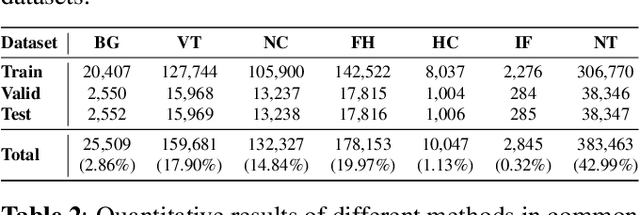
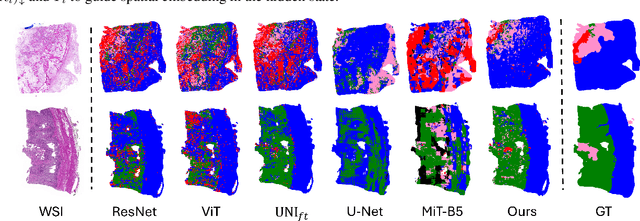

Abstract:Osteosarcoma, the most common primary bone cancer, often requires accurate necrosis assessment from whole slide images (WSIs) for effective treatment planning and prognosis. However, manual assessments are subjective and prone to variability. In response, we introduce FDDM, a novel framework bridging the gap between patch classification and region-based segmentation. FDDM operates in two stages: patch-based classification, followed by region-based refinement, enabling cross-patch information intergation. Leveraging a newly curated dataset of osteosarcoma images, FDDM demonstrates superior segmentation performance, achieving up to a 10% improvement mIOU and a 32.12% enhancement in necrosis rate estimation over state-of-the-art methods. This framework sets a new benchmark in osteosarcoma assessment, highlighting the potential of foundation models and diffusion-based refinements in complex medical imaging tasks.
Instruction-Guided Editing Controls for Images and Multimedia: A Survey in LLM era
Nov 15, 2024



Abstract:The rapid advancement of large language models (LLMs) and multimodal learning has transformed digital content creation and manipulation. Traditional visual editing tools require significant expertise, limiting accessibility. Recent strides in instruction-based editing have enabled intuitive interaction with visual content, using natural language as a bridge between user intent and complex editing operations. This survey provides an overview of these techniques, focusing on how LLMs and multimodal models empower users to achieve precise visual modifications without deep technical knowledge. By synthesizing over 100 publications, we explore methods from generative adversarial networks to diffusion models, examining multimodal integration for fine-grained content control. We discuss practical applications across domains such as fashion, 3D scene manipulation, and video synthesis, highlighting increased accessibility and alignment with human intuition. Our survey compares existing literature, emphasizing LLM-empowered editing, and identifies key challenges to stimulate further research. We aim to democratize powerful visual editing across various industries, from entertainment to education. Interested readers are encouraged to access our repository at https://github.com/tamlhp/awesome-instruction-editing.
CT to PET Translation: A Large-scale Dataset and Domain-Knowledge-Guided Diffusion Approach
Oct 29, 2024



Abstract:Positron Emission Tomography (PET) and Computed Tomography (CT) are essential for diagnosing, staging, and monitoring various diseases, particularly cancer. Despite their importance, the use of PET/CT systems is limited by the necessity for radioactive materials, the scarcity of PET scanners, and the high cost associated with PET imaging. In contrast, CT scanners are more widely available and significantly less expensive. In response to these challenges, our study addresses the issue of generating PET images from CT images, aiming to reduce both the medical examination cost and the associated health risks for patients. Our contributions are twofold: First, we introduce a conditional diffusion model named CPDM, which, to our knowledge, is one of the initial attempts to employ a diffusion model for translating from CT to PET images. Second, we provide the largest CT-PET dataset to date, comprising 2,028,628 paired CT-PET images, which facilitates the training and evaluation of CT-to-PET translation models. For the CPDM model, we incorporate domain knowledge to develop two conditional maps: the Attention map and the Attenuation map. The former helps the diffusion process focus on areas of interest, while the latter improves PET data correction and ensures accurate diagnostic information. Experimental evaluations across various benchmarks demonstrate that CPDM surpasses existing methods in generating high-quality PET images in terms of multiple metrics. The source code and data samples are available at https://github.com/thanhhff/CPDM.
FedMAC: Tackling Partial-Modality Missing in Federated Learning with Cross-Modal Aggregation and Contrastive Regularization
Oct 04, 2024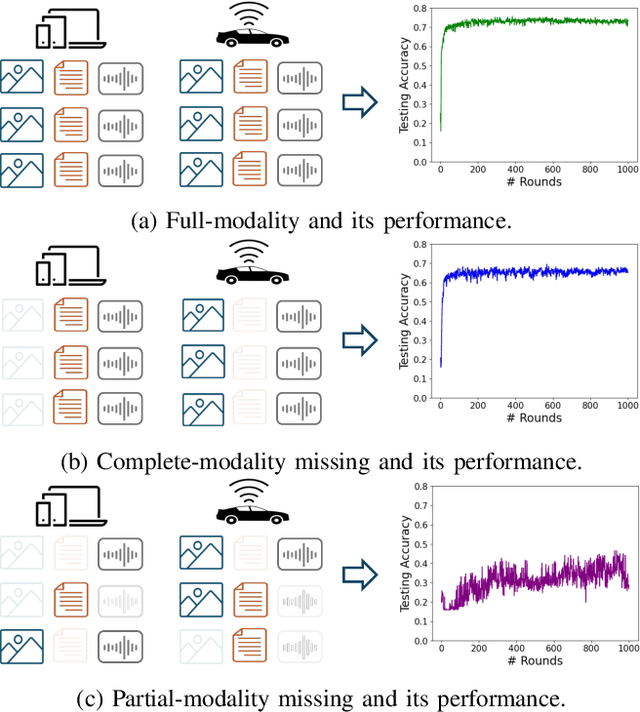
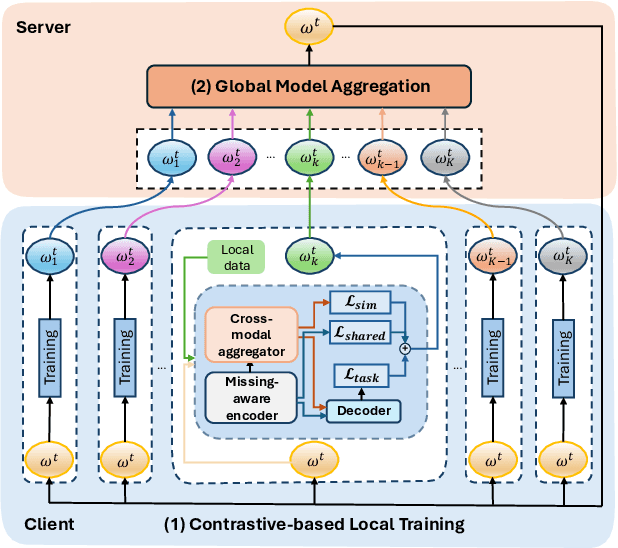
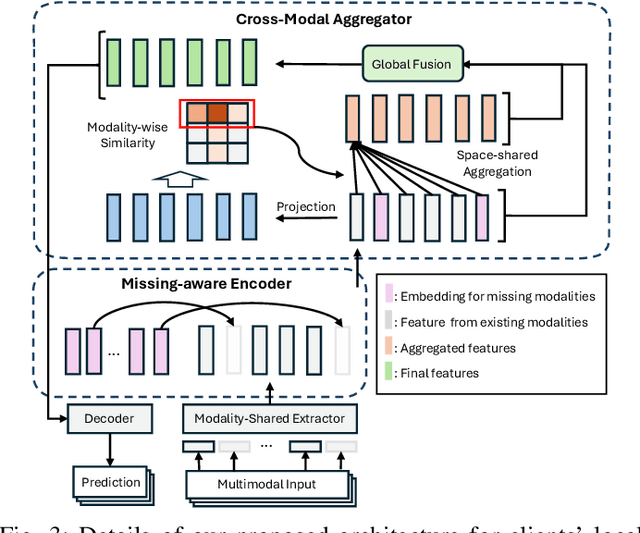
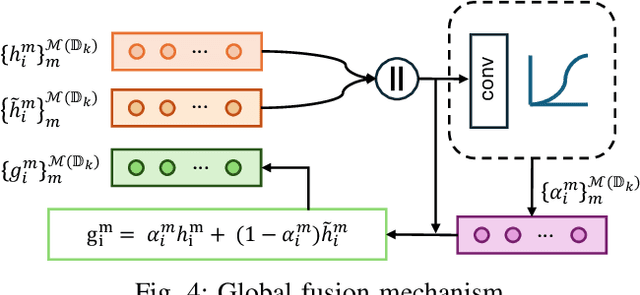
Abstract:Federated Learning (FL) is a method for training machine learning models using distributed data sources. It ensures privacy by allowing clients to collaboratively learn a shared global model while storing their data locally. However, a significant challenge arises when dealing with missing modalities in clients' datasets, where certain features or modalities are unavailable or incomplete, leading to heterogeneous data distribution. While previous studies have addressed the issue of complete-modality missing, they fail to tackle partial-modality missing on account of severe heterogeneity among clients at an instance level, where the pattern of missing data can vary significantly from one sample to another. To tackle this challenge, this study proposes a novel framework named FedMAC, designed to address multi-modality missing under conditions of partial-modality missing in FL. Additionally, to avoid trivial aggregation of multi-modal features, we introduce contrastive-based regularization to impose additional constraints on the latent representation space. The experimental results demonstrate the effectiveness of FedMAC across various client configurations with statistical heterogeneity, outperforming baseline methods by up to 26% in severe missing scenarios, highlighting its potential as a solution for the challenge of partially missing modalities in federated systems.
FedCert: Federated Accuracy Certification
Oct 04, 2024



Abstract:Federated Learning (FL) has emerged as a powerful paradigm for training machine learning models in a decentralized manner, preserving data privacy by keeping local data on clients. However, evaluating the robustness of these models against data perturbations on clients remains a significant challenge. Previous studies have assessed the effectiveness of models in centralized training based on certified accuracy, which guarantees that a certain percentage of the model's predictions will remain correct even if the input data is perturbed. However, the challenge of extending these evaluations to FL remains unresolved due to the unknown client's local data. To tackle this challenge, this study proposed a method named FedCert to take the first step toward evaluating the robustness of FL systems. The proposed method is designed to approximate the certified accuracy of a global model based on the certified accuracy and class distribution of each client. Additionally, considering the Non-Independent and Identically Distributed (Non-IID) nature of data in real-world scenarios, we introduce the client grouping algorithm to ensure reliable certified accuracy during the aggregation step of the approximation algorithm. Through theoretical analysis, we demonstrate the effectiveness of FedCert in assessing the robustness and reliability of FL systems. Moreover, experimental results on the CIFAR-10 and CIFAR-100 datasets under various scenarios show that FedCert consistently reduces the estimation error compared to baseline methods. This study offers a solution for evaluating the robustness of FL systems and lays the groundwork for future research to enhance the dependability of decentralized learning. The source code is available at https://github.com/thanhhff/FedCert/.
 Add to Chrome
Add to Chrome Add to Firefox
Add to Firefox Add to Edge
Add to Edge